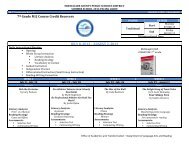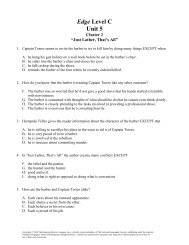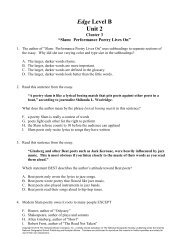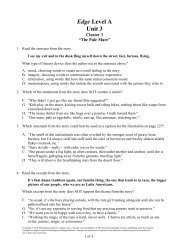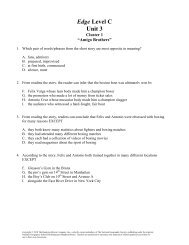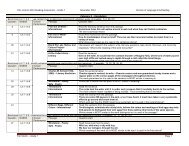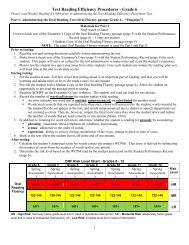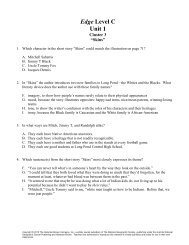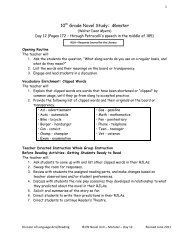Touching Spirit Bear - Division of Language Arts/Reading
Touching Spirit Bear - Division of Language Arts/Reading
Touching Spirit Bear - Division of Language Arts/Reading
- No tags were found...
You also want an ePaper? Increase the reach of your titles
YUMPU automatically turns print PDFs into web optimized ePapers that Google loves.
1Opening Routine:8 th Grade Novel Study: <strong>Touching</strong> <strong>Spirit</strong> <strong>Bear</strong>(Ben Mikaelsen)Celebrating Community: Learning About Ourselves and Others(Day 15 (Chapter 24)1. The teacher will: Read Aloud Article on Dance Therapy.2. Discuss Cole’s Dance <strong>of</strong> Anger as a form <strong>of</strong> therapeutic release <strong>of</strong> emotionsVocabulary Enrichment:Benchmark Focus – Inferences and Drawing Conclusions1. The teacher will display the Word Interview transparency and direct students tointerview the word “control” (synonyms: rule, manipulate, dictate, influence, dominate,oppress, have a hold over)Word Interview for the word – control1. Who are your relatives?2. Would you ever hurt anyone? Who? Why?3. Are you useful? What is your purpose?4. What don’t you like? Why?5. What do you love? Why?6. What are your dreams?Teacher Directed Whole-Group InstructionBefore <strong>Reading</strong>: Getting Students Ready to ReadDiscussion <strong>of</strong> Home Learning assignment:1. The teacher directs the students to the end <strong>of</strong> Chapter 23. The teacher asks,“Who is Cole apologizing to in his dance <strong>of</strong> anger?”“Who is he likely forgiving at the end <strong>of</strong> the dance?”“Do you believe that Cole’s healing is complete? What is next forhim?”During <strong>Reading</strong>: Experiencing the Text1. The teacher will read aloud page 195 up to the last paragraph on page 196.2. Now ask students what these two pages tell them about Cole’s healing and hisfuture goals.3. Was their prediction correct? (Cole realizes that to completely heal and put thisordeal in the past, he must find a way to help Peter.)4. The teacher directs students to continue reading with a buddy to the end <strong>of</strong> thechapter and selectively highlight or sticky note the support or evidence <strong>of</strong> Cole’shealing.<strong>Division</strong> <strong>of</strong> <strong>Language</strong> <strong>Arts</strong>/<strong>Reading</strong> IR-EN Novel Unit – <strong>Spirit</strong> <strong>Bear</strong> – Day 15 Revised June 2011
2After <strong>Reading</strong>: Understanding the TextBenchmark Content Focus: Validity and Accuracy1. The teacher will display Overhead <strong>of</strong> Conclusion/Support Two Column Notes.ConclusionCole is beginning to take charge <strong>of</strong>his own destiny.SupportPage 195 – “…something outsidecontrolled him. Cole didn’t like theidea that <strong>of</strong> being under the control<strong>of</strong> anybody or anything. Page 196 –“forgiving gives me control again.”ColeEdwinPeter2. Teacher Model: Ask students to draw a conclusion (or opinion) about Cole based onChapter 24. (See the example in the chart above). Explain to students that anyconclusion or opinion needs to be supported with evidence from the text.3. Teacher directs students to go back into the text to complete the graphicorganizer by composing another conclusion statement with support about Colelater in the chapter. Students should also include conclusion statements withsupport for Edwin and Peter.4. Teach asks students to use question task cards to write questions based on theirconclusions. The conclusions will serve as the answers. Students may use theirquestions to play Jeopardy.Differentiated Small Group InstructionCenter 1- Teacher Center – Data-driven instructional interventionCenter 2- Independent <strong>Reading</strong>Center 3- Technology<strong>Division</strong> <strong>of</strong> <strong>Language</strong> <strong>Arts</strong>/<strong>Reading</strong> IR-EN Novel Unit – <strong>Spirit</strong> <strong>Bear</strong> – Day 15 Revised June 2011
3Dance TherapyWhat Is It? How Does It Work? What You Can Expect Health Benefits How To Choose a PractitionerCautionsWhat Is It?Dance therapy (also called dance/movement therapy) is the use <strong>of</strong> choreographed or improvisedmovement as a way <strong>of</strong> treating social, emotional, cognitive, and physical problems. Throughout theages, people <strong>of</strong> many cultures have used dance to express powerful emotions, tell stories, treat illness,celebrate important events, and maintain communal bonds. Dance therapy harnesses this power <strong>of</strong>movement in a therapeutic setting and uses it to promote personal growth, health, and well-being.Dance as therapy came into existence as a marriage <strong>of</strong> sorts between modern dance and psychiatry. Itwas pioneered by Marian Chase (1896-1970), who studied dance in New York City before establishingher own studio in Washington, DC, in the 1930s. Because Chase's dance classes provided uniqueopportunities for self-expression, communication, and group interaction, psychiatrists in Washingtonbegan sending patients to her.By the mid-1940s Chase was giving lectures and demonstrations, and other pr<strong>of</strong>essional dancers soonfollowed her lead, using dance to help people with an array <strong>of</strong> emotional, mental, and physicalproblems. It was not until 1966, when the American Dance Therapy Association (ADTA) was founded,that dance therapy gained pr<strong>of</strong>essional recognition. Today the ADTA has nearly 1,200 members in 46states and 20 countries around the world.How Does It Work?Dance therapy is based on the premise that the body and mind are interrelated. Dance therapistsbelieve that mental and emotional problems are <strong>of</strong>ten held in the body in the form <strong>of</strong> muscle tension andconstrained movement patterns. Conversely, they believe that the state <strong>of</strong> the body can affect attitudeand feelings, both positively and negatively.Dance movements promote healing in a number <strong>of</strong> ways. Moving as a group brings people out <strong>of</strong>isolation, creates powerful social and emotional bonds, and generates the good feelings that comefrom being with others. Moving rhythmically eases muscular rigidity, diminishes anxiety, and increasesenergy. Moving spontaneously helps people learn to recognize and trust their impulses, and to act onor contain them as they choose. Moving creatively encourages self-expression and opens up new ways<strong>of</strong> thinking and doing.On a purely physical level, dance therapy provides the benefits <strong>of</strong> exercise: improved health, wellbeing,coordination, and muscle tone. On an emotional level, it helps people feel more joyful and confident,and allows them to explore such issues as anger, frustration, and loss that may be too difficult to exploreverbally. On a mental level, dance therapy seeks to enhance cognitive skills, motivation, and memory.Dance therapists can also address specific problems in specific ways. For example, to help apatient reduce stress, a dance therapist would first identify how the person's body reacts to stress,then explore specific movement techniques to increase circulation, deepen breathing, and reducemuscle tension.What You Can Expect?Your dance therapy experience will depend on your ailment, whether you work with a dance therapistin private practice or in the context <strong>of</strong> a treatment team, and whether you are the only patient or part <strong>of</strong>a group. And naturally different dance therapists have different styles. You need absolutely no previousdance training to benefit from dance therapy.Generally speaking, however, for the initial consultation, you will meet with the dance therapist in adance studio. You should wear comfortable clothing for this and all subsequent sessions. First, thetherapist will talk with you about your needs and your reasons for wanting treatment. Next, the therapistmay ask you to walk around the studio in order to analyze your body shape, posture, and movements: Isyour body erect or caved in? Do you reach out or hold yourself in? Do you move in a fluid or restrictedway? Finally, the dance therapist will discuss your treatment goals with you, and the two <strong>of</strong> you mightarrive at an agreement regarding the duration and nature <strong>of</strong> the therapy. You should review your goalswith the therapist periodically to see if you are meeting them.<strong>Division</strong> <strong>of</strong> <strong>Language</strong> <strong>Arts</strong>/<strong>Reading</strong> IR-EN Novel Unit – <strong>Spirit</strong> <strong>Bear</strong> – Day 15 Revised June 2011
4In your regular sessions, your dance therapist will watch you dance, encourage you to express yourfeelings through movement, and, at times, imitate your movements (this is called "empathic mirroring")to establish rapport and make you feel accepted. The therapist may also try to help you connect yourthoughts, feelings, and memories to your movements.If you are part <strong>of</strong> a dance therapy group, the dance therapist will typically assess how the group workstogether--how you all interact and share emotional expression through movement--and intervene ordirect the action accordingly. For example, the therapist might introduce the idea <strong>of</strong> leading andfollowing to help draw a member <strong>of</strong> the group out <strong>of</strong> isolation or self-preoccupation. The dancetherapist might also employ equipment such as beanbags, balls, and stretch cloths to explore a theme,such as trust.The number <strong>of</strong> sessions, both for individual and group work, will vary. You might have to commit to atleast six months <strong>of</strong> treatment, depending on your ailment. The sessions are usually weekly, althoughthis can vary as well.Health BenefitsDance therapy has a broad range <strong>of</strong> health benefits. It has been demonstrated to be clinicallyeffective at improving body image, self-esteem, attentiveness, and communication skills. It can alsoreduce stress, fears and anxieties, as well as lessen feelings <strong>of</strong> isolation, body tension, chronic pain,and depression. In addition it can enhance the functioning <strong>of</strong> the body's circulatory and respiratorysystems.Dance therapy has also been shown to benefit adolescent and adult psychiatric patients, the learningdisabled, the visually and hearing impaired, the mentally handicapped, and the elderly (especiallythose in nursing homes).Proponents <strong>of</strong> dance therapy claim that it has also been used successfully to help people deal withbrain injury, AIDS, arthritis, amputation, stroke, cancer, and a number <strong>of</strong> other physical ailments.How To Choose a PractitionerDance therapists work independently or as part <strong>of</strong> a treatment team, which might include an M.D.,psychiatrist, psychologist, and/or other health-care provider. Whichever you prefer, your primary-carephysician might be able to provide a referral. In addition, the American Dance Therapy Association(ADTA) in Columbia, Maryland, maintains a registry <strong>of</strong> dance therapists who meet specific educationaland clinical practice standards. These include:Dance Therapy Registered (DTR). This designation is granted by the ADTA to entry-level dancetherapists who have a master's degree and have completed 700 hours <strong>of</strong> supervised clinical internship.DTR therapists are qualified for employment as dance therapists, but cannot work in private practice.• Academy <strong>of</strong> Dance Therapists Registered (ADTR). This advanced designation is granted bythe ADTA to DTRs who have completed 3,640 hours <strong>of</strong> supervised clinical work in an agency,institution, or special school, and have met various other requirements. ADTR therapists are qualified toengage in private practice.CautionsIf you have a physical or psychological ailment, consult your primary-care physician first. Yourphysician can refer you to a dance therapist or supervise your care as part <strong>of</strong> a treatment team thatincludes a dance therapist.It is important to find a dance therapist with whom you feel comfortable, since the dance therapyexperience involves spontaneity, trust, and the expression <strong>of</strong> sometimes difficult emotions.<strong>Division</strong> <strong>of</strong> <strong>Language</strong> <strong>Arts</strong>/<strong>Reading</strong> IR-EN Novel Unit – <strong>Spirit</strong> <strong>Bear</strong> – Day 15 Revised June 2011
5Interview A Word1. Who are your relatives?_________________________________2. Would you ever hurt anyone?_________ Who?______________Why?_________________________3. Are you useful?________ What is your purpose? ________________________________________________________________4. What don’t you like?_______________ Why?______________________________________________________________________5. What do you love? ____________________________________Why?___________________________________________________6. What are your dreams? __________________________________<strong>Division</strong> <strong>of</strong> <strong>Language</strong> <strong>Arts</strong>/<strong>Reading</strong> IR-EN Novel Unit – <strong>Spirit</strong> <strong>Bear</strong> – Day 15 Revised June 2011
6ConclusionSupport<strong>Division</strong> <strong>of</strong> <strong>Language</strong> <strong>Arts</strong>/<strong>Reading</strong> IR-EN Novel Unit – <strong>Spirit</strong> <strong>Bear</strong> – Day 15 Revised June 2011



